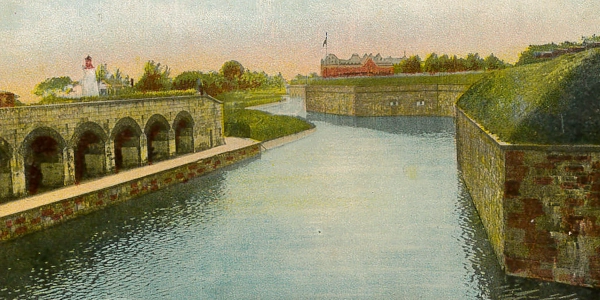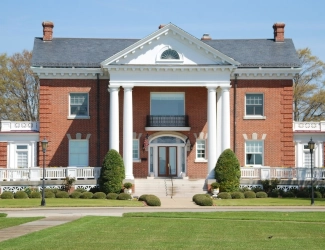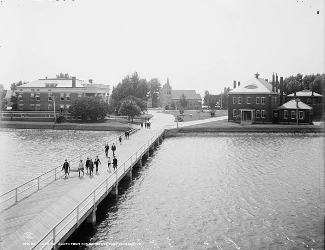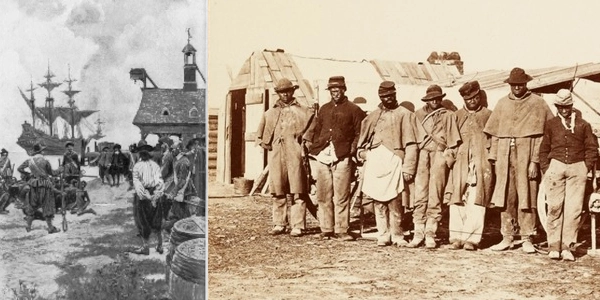
Above photo: Moat at Fort Monroe at Sunset, 2018, National Park Service. Right: Lithograph of Fort Monroe, Old Point Comfort, and the Hygeia Hotel, 1861/1862, unknown artist. Courtesy Library of Congress.

Fort Monroe National Monument
Although Fort Monroe is certainly not new to all its history, it's relatively new to being a visitor oriented national monument, designated such in the Obama Administration and its been adding and putting into place the plans for its transformation ever since. Now there's a wonderful Visitor Center in the old base library, a chance to visit the Casemate museum, wander around the outside of the fort to General's Row, the street where the houses of its officers were quartered, and learn its history from the days of being known as Point Comfort, with the bad history noted then, i.e. 1619 and slavery, to its days as a fortress to protect the Hampton Roads inlet and beyond that, Washington, D.C. from attack, both foreign and domestic.
Sponsor this page. Your banner or text ad can fill the space above.
Click here to Sponsor the page and how to reserve your ad.

Fortress Monroe Then
Fortications prior to Fort Monroe's construction began in 1609 with Fort Algernourne built to protect the colony at Jamestown. Fort George followed in 1727, but was destroyed by a hurricane in 1749. It was not rebuilt.
After the burning of Washington and the almost burning of Baltimore during the War of 1812, President Monroe's War Department thought that a better defense of the Chesapeake Bay was imperative and began plans in March 1819. Fort Monroe began construction in earnest in 1822, supervised, in part, by Robert E. Lee (1831-1834), and was predominantly completed in 1834, although work continued for more than a decade afterwards.
The fort would serve in the Civil War through the First and Second World Wars. During World War II, the Women's Army Corps arrived in late 1943; they were associated with the Coast Artillery School. The fort was headquarters to many U.S. Army commands and schools after that. It was decommissioned on September 15, 2011.
Image above: Photo of Trophy Circle in front of the post Y.M.C.A., 1910/1920, Detroit Publishing Company. Photo below: Postcard of Fort Monroe, 1900, with Old Point Comfort Lighthouse and the Chamberlin Hotel in the background. Courtesy Fort Monroe Authority's Casemate Museum.

Fort Monroe Now
The park has been undergoing its transformation since Obama's declaration using the Antiquities Act on November 1, 2011, with now a plan combining the National Park Service, the Fort Monroe Authority, the U.S. Army, and the City of Hampton, to give visitor services and other adaptive uses to the hundreds of buildings within and surrounding the fort.
There are piers to fish from, Engineer Wharf and the Finger Pier, near Continental Park. Saltwater fishing license required. Since Fort Monroe is an island, there are beaches galore; Outlook Beach is the only public beach with lifeguards. Dogs are not allowed on the beaches in the summer.
But if you're coming for history, then you're looking at the fort, its museum in the Visitor Center, the Casement Museum, and the history of the hundreds of buildings therein. And there's so many stories to tell and learn about. You'll learn the really bad and somewhat good history of slavery here, see where Robert E. Lee was housed during its construction, and the cell of Jefferson Davis when he was imprisoned after the war.
T-Shirts and Souvenirs

Fort Monroe National Monument T-Shirts and other history souvenirs from the official merchandise of America's Best History.

Fort Monroe
Things You Should Not Miss
1. The Visitor Center is a must for its exhibits, orientation, and more. Its also the gateway to tickets for getting inside the Casemate Museum, which, if you're visiting, you have to see. Some days there are ranger walks, and in summer a concert series, Music by the Bay, is held once a week. Ask for its location.
2. Head to the Old Point Comfort Lighthouse. It's still operating, so you'll only get to gaze at it from outside. Nice place to picnic.
3. Before you head out of the walls to other attractions, take a short stroll within the parade grounds and within the oaks that surround it. Used more for recreation than training, find the Algernourne Oak, it's five hundred years old.
4. Take a walk down General's Row on Fenwick Street, and just think of all the Army's commanders who at one time were housed there, from the years after the War of 1812 to the Civil War to both World War I and II.
5. Are you hungry? Then head over to the Paradise Beach Club. It's open to the public for meals and events, but private for beach access.
Photo above: Battery Church at Sunset, built in the 1890's during the period of the Spanish American War. Courtesy National Park Service.





